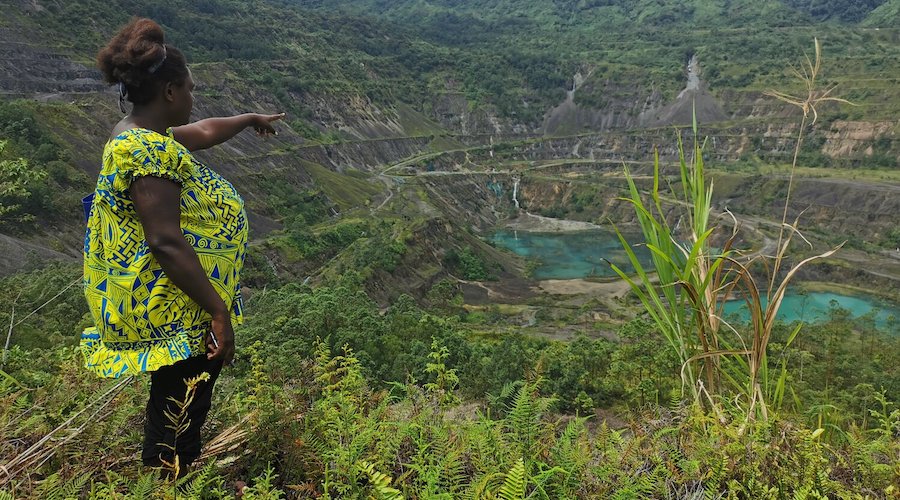
Bougainville had a history of small-scale mining. But the identification of a major gold, copper and silver orebody at Panguna in the 1960s prompted Bougainville Copper Ltd, (BCL) a subsidiary of Rio Tinto, to start operations of a major mine.
BCL says Panguna has an estimated 5.3 million tonnes of copper and 19.3 million ounces of gold, which would make the reserves worth about $60 billion at today’s prices.
In September 2020, the HRLC, representing 156 residents of villages in the vicinity of the Panguna mine, filed a complaint with the AusNCP against Rio Tinto. The complaint alleges that Rio Tinto is accountable for significant breaches of the OECD Guidelines for Multinational Enterprises relating to past and ongoing environmental and human rights impacts allegedly arising from the Panguna mine.
Bougainville had a history of small-scale mining. But the identification of a major gold, copper and silver orebody at Panguna in the 1960s prompted a subsidiary of Rio Tinto to start operations of a major mine
Bougainville was given greater autonomy within PNG with a non-binding referendum in favour of independence held in 2019.
The agreement follows several months of constructive discussions facilitated by the Australian OECD National Contact Point (AusNCP).
“This is an important day for communities on Bougainville. Our people have been living with the disastrous impacts of Panguna for many years and the situation is getting worse,” Traditional landowner and MP Theonila Roka Matbob said in a media release.
“These problems need to be urgently investigated so solutions can be developed and clean-up can begin,” Matbob said. “Today’s announcement gives us hope for a new chapter for our people. We look forward to working with Rio Tinto, the Human Rights Law Centre and our own government and communities to ensure work on the assessment can start as soon as possible.”
A joint committee of stakeholders will be formed to oversee a detailed independent assessment of the Panguna mine to identify and better understand actual and potential environmental and human rights impacts of the mine which ceased operating in 1989, Rio said in a media statement.
The Panguna Mine Legacy Impact Assessment Committee will be established by the Autonomous Bougainville Government (ABG) and the parties to the AusNCP process, Rio Tinto, the HRLC and the community members the HRLC represents.
It will be chaired by an independent facilitator with representatives invited to join the Committee from the Independent State of Papua New Guinea (PNG), ASX-listed Bougainville Copper Limited (BCL), as well as other landowners and community representatives.
“This is an important day for communities on Bougainville. Our people have been living with the disastrous impacts of Panguna for many years”
Traditional landowner and MP Theonila Roka Matbob
“This is an important first step towards engaging with those impacted by the legacy of the Panguna mine. It comes after months of constructive engagement with the HRLC and the community members they represent facilitated by the Australian National Contact Point, as well as engagement with other key stakeholders including the Autonomous Bougainville Government,” Rio Tinto chief executive Jakob Stausholm said in the statement.
“Operations at Panguna ceased in 1989 and we’ve not had access to the mine since that time. Stakeholders have raised concerns about impacts to water, land and health and this process will provide all parties with a clearer understanding of these important matters, so that together we can consider the right way forward,” Stausholm said.
The scope of the Impact Assessment, along with terms of reference for the Committee, have been drafted by the parties to the AusNCP process. The Impact Assessment will be predominantly funded by Rio Tinto with BCL contributing separately, provided that broader stakeholders on the Committee endorse the process and proposed methodology of the Impact Assessment, the Impact Assessment can be safely completed and an appropriate funding mechanism can be agreed. The ABG has confirmed its support for the process.
The Committee will appoint a chairperson and an independent third-party company (or consortium) to complete the Impact Assessment with strong environmental and human rights expertise as well as both global and regional experience.
“We are pleased that Rio Tinto has acknowledged the very serious concerns raised by communities by agreeing to fund this assessment,” said Keren Adams, Legal Director at the Human Rights Law Centre in a separate statement.
“The Panguna mine left a devastating legacy of environmental pollution which continues to impact the lives of thousands of people,” Adams said. “This assessment is a critical first step towards addressing that legacy. The assessment will need to be followed up by swift action to address these problems so that communities can live in safety.”
Following the Impact Assessment, Rio Tinto and the other parties to the AusNCP process will discuss the recommendations from the Impact Assessment and the remaining commitments sought by the communities.




